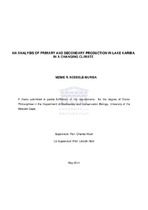| dc.description.abstract | Analysis of temperature, rainfall and evaporation records over a 44-year period spanning the years 1964 to 2008 indicates changes in the climate around Lake Kariba. Mean annual temperatures have increased by approximately 1.5oC, and pan evaporation rates by about 25%, with rainfall having declined by an average of 27.1 mm since 1964 at an average rate of 6.3 mm per decade. At the same time, lake water temperatures, evaporation rates, and water loss from the lake have increased, which have adversely affected lake water levels, nutrient and thermal dynamics. The most prominent influence of the changing climate on Lake Kariba has been a reduction in the lake water levels, averaging 9.5 m over the past two decades. These are associated with increased warming, reduced rainfall and diminished water and therefore nutrient inflow into the lake. The warmer climate has increased temperatures in the upper layers of lake water, the epilimnion, by an overall average of 1.9°C between 1965 and 2009. The warmer epilimnion has led to a more stable thermocline in the lake, and its upward migration from a previously reported 20 m depth to the current 2 to 5 m depth reported in the lake’s Sanyati Basin. A consequence of the more stable thermocline has been the trapping of greater amounts of nutrients in the deep, cold bottom waters of the lake, the hypolimnion, and this coupled with a shorter mixing (turnover) period is leading to
reduced nutrient availability within the epilimnion. This is evident from a measured 50% reduction in nitrogen levels within the epilimnion, with phosphorus levels displaying a much smaller net decline due to localised sources of pollution inflows into the lake. These changes in lake thermal dynamics and density stratification have reduced the volume of the lake epilimnion by ~50%, which includes the well mixed, oxygenated euphotic zone leading to more acidic waters (lower pH) and increased water ionic concentrations (conductivity), and decreased dissolved oxygen levels, which
have resulted in a 95% reduction in phytoplankton biomass and a 57% decline in primary production rates since the 1980s. The reduced nitrogen levels especially have contributed to a proliferation of nitrogen-fixing Cyanophyceae, the dominant Cylindrospermopsis raciborskii comprising up to 66% of the total phytoplankton biomass and 45.6% of the measured total phytoplankton cellular concentrations. Also, shifts in seasonal dominance of different phytoplankton groups have been observed in the lake during turnover, the Cyanophyceae having increased in dominance from 60% of the total phytoplankton biomass in the early 1980’s to the current 75%. In contrast, the Bacillariophyceae have declined substantially, from 18% of the total phytoplankton biomass in the early 1980’s to the current 1.7%. The diminished phytoplankton
biomass of more palatable phytoplankton, and the proliferation of smaller, less palatable
phytoplankton taxa, has resulted in reduced zooplankton biomass and species richness and altered zooplankton species composition. Concentrations of large Cladocera and Copepoda especially have declined substantially in the lake by up to 93.3% since the mid 1970s, with small Rotifera currently comprising 64% of the total zooplankton biomass. The reductions in zooplankton biomass correspond with recorded decreases in catches per unit effort for the sardine Limnothrissa miodon (Kapenta), which have been steadily declining in the lake since 1986. | en_US |

